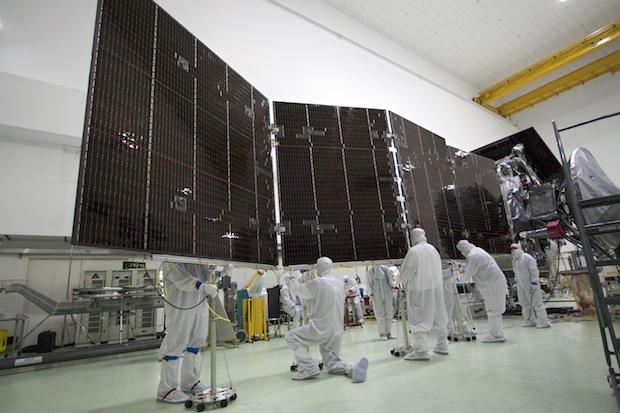Space Missions to Watch in 2016
Jan. 17: Launch of Jason-3 Earth-observing satellite
On Sunday (Jan. 17), the U.S. National Oceanic and Atmospheric Administration's (NOAA) Jason-3 satellite is scheduled to launch to Earth orbit atop a SpaceX Falcon 9 rocket from Vandenberg Air Force Base in California.
Feb. 7: SpaceX's return-to-flight cargo mission
SpaceX holds a $1.6 billion contract with NASA to fly at least 12 robotic resupply missions to the International Space Station (ISS) using the Falcon 9 and the company's uncrewed Dragon capsule. The first six such flights went perfectly, but the seventh ended just minutes after liftoff on June 28, 2015, when the Falcon 9 broke apart in the Florida skies.
March 14: Launch One for Europe's ExoMars mission
The European Space Agency (ESA) is scheduled to launch the first part of its ExoMars mission on March 14, blasting the Trace Gas Orbiter (TGO) on a seventh-month journey toward the Red Planet along with a technology-demonstrating lander
March 18: Astronauts launch toward International Space Station
NASA astronaut Jeffrey Williams and cosmonauts Aleksey Ovchinin and Oleg Skripochka are slated to launch toward the ISS on March 18. The trio will blast off in a Russian
Soyuz spacecraft from Baikonur Cosmodrome in Kazakhstan.
April: Maiden launch of SpaceX's Falcon Heavy rocket
At some point in April, SpaceX plans to launch its huge
Falcon Heavy rocketfor the first time, with the liftoff taking place from Florida's Cape Canaveral Air Force Station. The 224-foot-tall (68 meters) Falcon Heavy will be the most powerful booster in the world when it's operational, capable of lofting 53 metric tons to low Earth orbit, SpaceX representatives say.
Summer: End of NASA's Dawn mission?
NASA's Dawn spacecraft has been orbiting Ceres since March 2015, studying the heavily cratered dwarf planet's mysterious bright spots and other intriguing features. Last month, Dawn finished spiraling down to its final science orbit, and is now taking pictures and making measurements from an altitude of just 230 miles (375 km).
July 4: Juno arrives at Jupiter
NASA's
Juno spacecraft is scheduled to enter orbit around Jupiter on July 4, nearly five years after the probe blasted off.
The solar-powered Juno will map out Jupiter's magnetic and gravitational fields precisely, revealing key details about the giant planet's evolution and structure — including whether or not it has a solid core, NASA officials have said.
Sept. 3: NASA asteroid-sampling probe blasts off
Another NASA spaceflight milestone comes on Sept. 3, with the scheduled launch of the agency's Origins-Spectral Interpretation-Resource Identification-Security-Regolith Explorer mission, or OSIRIS-REx for short.
The
OSIRIS-REx spacecraft will head toward a 1,650-foot-wide (500 m) asteroid named Bennu, and, if everything goes according to plan, will arrive at the potentially hazardous space rock in 2018. OSIRIS-REx will snag at least 2.1 ounces (60 grams) of Bennu material and bring the sample back to Earth in 2023.
Sept. 30: Historic Rosetta comet mission ends
The first mission ever to orbit and land on a comet will wrap up on Sept. 30, when ESA's Rosetta spacecraft spirals down onto the surface of the 2.5 mile-wide (4 km) Comet 67P/Churyumov–Gerasimenko
Late 2016: Europe's satellite-navigation system up and running
Europe's own version of the United States' Global Positioning System (GPS) should be operational by the end of the year, ESA officials say.
Four more spacecraft for Europe's
Galileo satellite-navigation network are slated to launch this year, allowing the system to start providing initial services sometime in 2016. Galileo, which is civilian-run (in contrast to the military-run GPS network) will eventually consist of 30 Earth-orbiting satellites — 24 operational spacecraft, plus six spares. Twelve Galileo satellites have been launched to date.
All year: Testing of future crewed spaceships
This year, engineers and technicians will continue to develop and test a variety of spacecraft designed to help humanity explore the final frontier.
Suborbital vehicles such as Virgin Galactic's SpaceShipTwo, XCOR Aerospace's Lynx rocket plane and Blue Origin's New Shepard system will be put through their paces, as will orbital craft such as Sierra Nevada's Dream Chaser space plane, SpaceX's Dragon V2 capsule and Boeing's CST-100 Starliner capsule.
Indeed, SpaceX and Boeing are working to get Dragon V2 (which is an advanced version of the company's robotic Dragon cargo capsule) and Starliner ready to carry NASA astronauts to and from the International Space Station beginning in 2017; Dragon V2 may make its maiden flight, an uncrewed test, before 2016 is done. (In September 2014, the space agency awarded SpaceX and Boeing $2.6 billion and $4.2 billion, respectively, to get the two capsules ready to fly.)
And NASA will continue developing its Orion crew capsule, which will help get agency astronauts to deep-space destinations such as asteroids and, eventually, Mars. (SpaceX has also said Dragon could journey to Mars, as well as a variety of other destinations throughout the solar system.)
















































